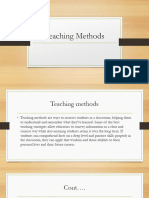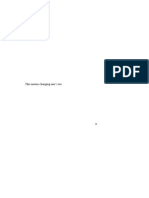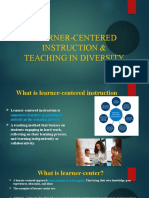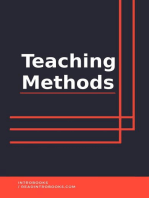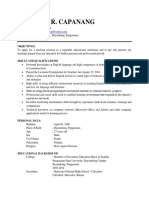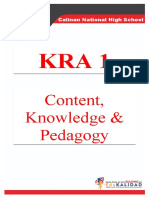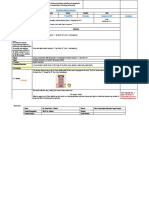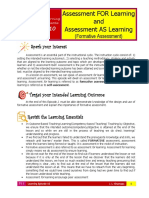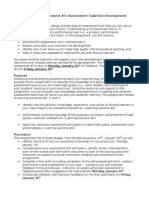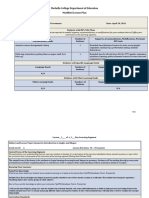Approaches in Teaching
Approaches in Teaching
Uploaded by
CZARINA MAY REGALADOCopyright:
Available Formats
Approaches in Teaching
Approaches in Teaching
Uploaded by
CZARINA MAY REGALADOOriginal Title
Copyright
Available Formats
Share this document
Did you find this document useful?
Is this content inappropriate?
Copyright:
Available Formats
Approaches in Teaching
Approaches in Teaching
Uploaded by
CZARINA MAY REGALADOCopyright:
Available Formats
9 Teaching Methods To Promote Success
in the Classroom
Indeed Editorial Team
Updated December 6, 2023
With the right teaching methods, educators can create an enjoyable and
productive classroom experience for students where they can learn important
academic and social skills to last a lifetime. There are many frameworks that a
teacher could use to support students with different interests, abilities and
learning styles. If you're a teacher or professional in the education field, you
might benefit from learning about new instructive strategies in the field to
maximize your students’ chances of success in your classroom. In this article,
we define what teaching methods are, explore nine types of teaching methods,
review the benefits of these methods and provide some tips for doing so
successfully.Key takeaways:
Teaching methods are techniques that educators can use to
facilitate the teaching process and help students feel engaged
and interested in the material.
Types of teaching methods include differentiated instruction,
lecture-based instruction, technology-based learning, group
learning, individual learning, inquiry-based learning, kinesthetic
learning, game-based learning and expeditionary learning.
Improve your teaching methods by testing different ones using
the same lesson, meeting with other teachers to get their
perspectives and remaining flexible.
What are teaching methods?
Teaching methods are ways to instruct students in a classroom, helping them
to understand and remember what they've learned. Some of the best teaching
strategies allow educators to convey information in a clear and concise way
while also ensuring students retain it over the long term. If students can
comprehend facts on a deep level and practice skills properly in the classroom,
they can apply that wisdom and those abilities to their personal lives and their
future careers.Teaching methods are opportunities to make learning engaging,
inspiring and fun for students. They aid teachers in fulfilling the responsibility
of guiding the social and emotional development of children. By using the right
strategies, teachers can instill values of respect, empathy and cultural
sensitivity into their classroom. They also use teaching methods to prepare
students for standardized testing. Your classroom philosophies and principles
can vary based on your preferences as a teacher, your school mission
statement, your subject areas and other factors.Related: 9 Strategies for ELL
Teachers To Use in Their Classrooms
Types of teaching methods
There are many kinds of procedures a teacher can use in a classroom. Many of
them are similar in purpose, and educators can use a blend of instruction
methods to best fit the needs of their students. Here are nine typical
approaches to consider:
1. Differentiated instruction
Differentiated instruction is the idea of creating tailored education plans for
students based on differing needs. This may involve the ways by which
students access content, the activities they do, the assessment techniques a
teacher uses or even the physical setup of a classroom. As all people have
varying abilities and talents, it's beneficial for a teacher to adapt their teaching
styles to unique students. This is also a key step in supporting students with
disabilities in the classroom and ensuring they feel welcome and comfortable
in academic environments. Here are some ways an educator may differentiate
instruction:
Provide books or other materials at different reading levels.
Create custom spelling lists for students with different spelling
skills.
Host small groups to provide tailored advice to students.
Offer one-on-one after-school help to students encountering
challenges.
Discuss student progress and at-home educational strategies
with parents.
Measure progress in different ways, through projects, portfolios
and participation.
2. Lecture-based learning
A traditional way to structure classroom learning is the lecture format, in
which teachers explain information while students observe. Teachers lead a
lesson by presenting on, showing visuals of and modeling examples of a topic.
While a teacher is presenting, students can listen, watch, take notes and copy
the teacher's demonstrations. While this is a conventional and helpful
approach, teachers may alter it for different learning environments.Here are
some ways that teachers ensure the success of lecture-based learning:
Keep lessons brief: Students, especially those at a young age,
may have short attention spans and might only be able to focus
for short periods of time. It can be advantageous to keep
classroom lectures short and concise to maintain student
attention and engagement.
Allow time for questions: While lecture-based learning is a
teacher-centered approach, educators can still involve student
input by making time for questions before, during and after the
presentation. While this can make the lecture process longer, it
can also allow students to engage with the material, comprehend
it and remember it more easily.
Create instructional videos: Many teachers use a flipped
classroom approach where they encourage students to watch
lectures or instructional videos at home and complete
assignments in class. This can be a great opportunity to let
students work at their own pace, as they can see videos again by
rewinding and replaying them.
Use visual cues: Whether in or outside of the academic
environment, using visual cues in presentations such as icons,
images and videos can be a great way to keep your audiences
interested in the content. Make sure to use high-contrast colors
and bold shapes and lines so students across your classroom can
see and understand your messages.
Promote handwritten notes: For those students who are able,
hand-writing notes on paper can be a superb way to stay focused
during lectures. It can also help people to recall information well
and strengthen their spelling and writing skills.
Related: Learning Styles and How To Accommodate Them
3. Technology-based learning
Teachers can use technology in the classroom to make teaching processes
more efficient and aid in student learning. Students can use devices like
computers and tablets to read materials, conduct research or play educational
games. In addition, cloud computing capabilities make it possible for students
to access documents or other resources while at school or at home. Virtual
classrooms using video conferencing software can be a great way to provide
education remotely. This can be especially helpful for students with disabilities
who may have difficulties focusing in a physical classroom
environment.Related: 10 Skills To Become Technology Savvy (Plus Helpful
Tips)
4. Group learning
Segmenting students into groups is a great way to teach them skills in
collaboration. While in their teams, they can discuss subjects and learn about
the perspectives of others. It's important to encourage both class participation
and listening skills so that students can gain these abilities for the future.
Teachers can assign group presentations so students can convey information
to the rest of the class, ask and answer questions and interact with each
other.Related: Group Communication: Definition, Types and Best Practices
5. Individual learning / Learner Centered
While group projects can be exciting opportunities for students, it's also
important to promote individual learning so that they can work by themselves.
Assigning journal entries can be an excellent way to give students time to
think through topics and develop thoughts and analyses. This is especially
helpful before hosting a class discussion so class members can have ideas for
what to say. Teachers can read writing assignments to reward points to
students who can't participate vocally in class.
6. Inquiry-based learning
Inquiry-based learning promotes the idea of learning by investigation, where
students can complete projects, ask questions and find answers by
themselves. While teachers act as resources in these times, the goal is for
students to solve problems and discover information on their own. Upon
learning about concepts, they can explain and present the concepts in their
own words to further enforce them in their memories. Then, students can
advance to higher levels at their own pace. This is a way for students to
perform an active role in the learning process.Related: How To Create Your
Own Problem-Solving Process
7. Kinesthetic learning
Kinesthetic learning is the notion of learning through movement. Teachers can
move around the classroom and use hand gestures while they present to
engage students visually and kinesthetically. They can also encourage
students to perform physical activities where they can move around and use
their creativity. Here are some ideas:
Drawing: Many students enjoy drawing or painting, and teachers
can include this activity in the classroom to make learning
enjoyable. Students can have the option to develop ideas and use
different colors and tools to make their ideas a reality.
Acting: Students, especially young children, may have an
exciting time developing and role-playing in theatrical
performances. This can be a great idea for implementing
kinesthetic learning in group projects.
Building: Building structures with blocks, toys or other materials
can help students develop hand-eye coordination and analytical
thinking skills. It can also be a fun way for them to stay focused
in the classroom.
Playing: A traditional form of kinesthetic learning is playing
sports, and many schools have gym classes where students can
exert energy and spend time outside. You can also have
educational sports games in the classroom, where students can
move around and learn simultaneously.
Related: Guide to Kinesthetic Learning: Definition, Benefits and Careers
8. Game-based learning
If you want to update your classroom techniques and help children to be more
excited about learning, consider developing and implementing educational
games or challenges, whether in-person or online. These can inspire children,
especially kinesthetic learners, to participate more fully in the learning
process and keep them motivated and focused on lessons. It can also allow
them the opportunity to solve problems and reach a goal.
Related: 20 Fun Classroom Games You Can Try (Plus Their Benefits)
9. Expeditionary learning
Expeditionary learning is the process of learning through participating in
practical experiences. These can be projects, case studies or lab experiments
in the classroom or field trips to places around your school and community. For
example, in a science class, you might take a trip to a nearby nature center to
learn about the types of animals and plants in your area. This type of approach
encourages students to apply classroom knowledge and skills to the real
world. It can help them comprehend the purpose of their efforts and return to
schoolwork with enthusiasm.Related: 23 Cognitive Activities You Can Practice
With Children
Benefits of using teaching methods
Using teaching methods can make the job duties of educators easier and more
effective. Here are some benefits of this process:
Teaching your students effectively: You can use effective
teaching methods that educators have been using throughout
history to help people learn. Paying attention to the way you
teach students, in addition to the content you convey to them, is
a critical part of ensuring they master subjects and abilities.
Planning your educational content: In any career field,
conducting the proper amount of planning and preparation can
ensure your work is efficient and error-free. Planning your
teaching methods for the day, week, month, quarter or year can
support well-functioning lessons and classroom activities.
Finding the best ways to connect with your
students: Experimenting with various teaching methods allows
you to gauge what your students need and govern your classroom
well. You can discover the teaching styles that lead to better
performance on assessments and better progress reports.
You might also like
- Week 1 DLL Bus. Finance FinalDocument5 pagesWeek 1 DLL Bus. Finance FinalMichelle Vinoray Pascual80% (5)
- Teaching StrategiesDocument24 pagesTeaching StrategiesRania MohammedNo ratings yet
- Team 7: Exploring More Interactive and Innovative Teaching Strategies For Diverse LearnersDocument22 pagesTeam 7: Exploring More Interactive and Innovative Teaching Strategies For Diverse LearnersJessabel ColumnaNo ratings yet
- Teaching MethodeDocument12 pagesTeaching Methodeismannaba7No ratings yet
- Teaching MethodsDocument18 pagesTeaching MethodsKosar YounisNo ratings yet
- The Classroom Is A Dynamic EnvironmentDocument23 pagesThe Classroom Is A Dynamic EnvironmentAna De CastroNo ratings yet
- Differentiated Instruction DiscussionDocument8 pagesDifferentiated Instruction DiscussionChristine Dragon LlantoNo ratings yet
- 6 Best Teaching Strategies For 2023Document4 pages6 Best Teaching Strategies For 2023Access PointNo ratings yet
- Definition and Understanding PRITA ASSIGNDocument7 pagesDefinition and Understanding PRITA ASSIGNMAHENDRA KUMAR A/L KANESON MoeNo ratings yet
- 50 Innovative Tching Strat. in ScienceDocument19 pages50 Innovative Tching Strat. in ScienceHoneyjo NetteNo ratings yet
- Review Materials LET LCDocument5 pagesReview Materials LET LCLOUIE ALVAREZNo ratings yet
- 7 Effective Teaching Strategies WordDocument4 pages7 Effective Teaching Strategies WordChristian Bacnis AgpoonNo ratings yet
- Portfolio Assignment Educ 5281 Unit 3Document4 pagesPortfolio Assignment Educ 5281 Unit 3مساحة أفكارNo ratings yet
- Teaching Strategies, Selection and Classification of StrategiesDocument5 pagesTeaching Strategies, Selection and Classification of StrategiesKarla De Guzman HornillaNo ratings yet
- Teaching Strategies-1Document2 pagesTeaching Strategies-1Aicha BoudehaneNo ratings yet
- A Thousand Teachers A Thousand MethodsDocument13 pagesA Thousand Teachers A Thousand MethodsMargie Macay LastimosaNo ratings yet
- Hand OutDocument11 pagesHand OutGlensky Nadz NumbarNo ratings yet
- Five Strategies Teachers Use To Facilitate LearninDocument3 pagesFive Strategies Teachers Use To Facilitate Learninxinghai liuNo ratings yet
- Lesson Planning-PDP-PS Group AssignmentDocument7 pagesLesson Planning-PDP-PS Group AssignmenthrishikeshNo ratings yet
- Advanced Principles and Methods of TeachingDocument4 pagesAdvanced Principles and Methods of TeachingJerric AbreraNo ratings yet
- Bruners Scaffolding TheoryDocument6 pagesBruners Scaffolding TheoryVictoriaNo ratings yet
- Saliha Afzal: M.Ed Special Education Assignment 1 Code 0846Document14 pagesSaliha Afzal: M.Ed Special Education Assignment 1 Code 0846AEO MARKAZ BhalowaliNo ratings yet
- Notes #4Document3 pagesNotes #4jolaiNo ratings yet
- The Classroom Is A Dynamic EnvironmentDocument10 pagesThe Classroom Is A Dynamic EnvironmentAndrea AlcoranoNo ratings yet
- VicsonDocument11 pagesVicsonEdz LuzNo ratings yet
- What Is Teaching-Learning Process?Document46 pagesWhat Is Teaching-Learning Process?Glenn E. DicenNo ratings yet
- 6 Strategies For Teaching Special Education ClassesDocument2 pages6 Strategies For Teaching Special Education Classesjoel dizonNo ratings yet
- Code 8601Document12 pagesCode 8601عائشہ حسینNo ratings yet
- Teaching Practices and Benefits Module (Written Report)Document7 pagesTeaching Practices and Benefits Module (Written Report)Jesamie Bactol SeriñoNo ratings yet
- Beed 16 Final ExaminationDocument16 pagesBeed 16 Final ExaminationDesyrie Joy Soriano DirayNo ratings yet
- TIC 02 Lecture Notes The Outcomes Approach: 1. Clarity of Focus Through Learning OutcomesDocument4 pagesTIC 02 Lecture Notes The Outcomes Approach: 1. Clarity of Focus Through Learning OutcomesJay DexNo ratings yet
- 8601, Assignment 1Document14 pages8601, Assignment 1Abdul WajidNo ratings yet
- 8601 SolutionDocument14 pages8601 SolutionAsad AliNo ratings yet
- Argument 1Document6 pagesArgument 1Neng MulikNo ratings yet
- SOCIAL STUDIES Activity No. 6Document4 pagesSOCIAL STUDIES Activity No. 6Jen AMBNo ratings yet
- Part IDocument12 pagesPart IJenn PundavelaNo ratings yet
- Semi Final Special Topic 1Document8 pagesSemi Final Special Topic 1viancakesdumpNo ratings yet
- Be Employed in Each Approach. Provide Guidelines For Using These Approaches in The Classrooms."Document3 pagesBe Employed in Each Approach. Provide Guidelines For Using These Approaches in The Classrooms."Henry BuemioNo ratings yet
- Create Learning Stations: Flexible Seating PlanDocument15 pagesCreate Learning Stations: Flexible Seating PlanlevyNo ratings yet
- Every Classroom Brings Together Students With Distinct Abilities and PersonalitiesDocument3 pagesEvery Classroom Brings Together Students With Distinct Abilities and Personalitiesapi-547884434No ratings yet
- 7 Effective Teaching Strategies For The Classroom: F E B R U A R Y 2 3, 2 0 1 8Document4 pages7 Effective Teaching Strategies For The Classroom: F E B R U A R Y 2 3, 2 0 1 8Roscela Mae D. ArizoNo ratings yet
- LESSON 6: Instructional Models For Social Studies: Intended Learning OutcomeDocument3 pagesLESSON 6: Instructional Models For Social Studies: Intended Learning OutcomeDONAIRE PRINCESS ANN100% (2)
- Differetiated Instruction StrategiDocument25 pagesDifferetiated Instruction StrategiSalmizam Izam100% (1)
- 7 Effective Teaching Strategies For The Classroom: F E B R U A R Y 2 3, 2 0 1 8Document26 pages7 Effective Teaching Strategies For The Classroom: F E B R U A R Y 2 3, 2 0 1 8julienne tadaoNo ratings yet
- FL Bece1Document46 pagesFL Bece1Jay VaronaNo ratings yet
- Committed To Excellence in Innovation: Differentiated Assessment ToolDocument8 pagesCommitted To Excellence in Innovation: Differentiated Assessment ToolMhay Anne PerezNo ratings yet
- Glaica Mañoso Task 3Document4 pagesGlaica Mañoso Task 3Glaica MañosoNo ratings yet
- The Teacher'S Role, Student'S Role, Content Organisation, Delivery and Assessment in Learner-Centred TeachingDocument5 pagesThe Teacher'S Role, Student'S Role, Content Organisation, Delivery and Assessment in Learner-Centred TeachingNashKlasikNasrahMihatNo ratings yet
- Module 3Document28 pagesModule 3RexonChanNo ratings yet
- Explanation in APDocument3 pagesExplanation in APMaelannNo ratings yet
- Teaching Strategies: Ncm102/N: Health EducationDocument48 pagesTeaching Strategies: Ncm102/N: Health EducationCasey Wruble100% (1)
- 8601 - 2Document19 pages8601 - 2umerNo ratings yet
- Materi Poster (Individual DIfference)Document4 pagesMateri Poster (Individual DIfference)wisraalifyardaniNo ratings yet
- Module 1: Effective Teaching: I-ObjectivesDocument6 pagesModule 1: Effective Teaching: I-ObjectivesGraciella MabalingNo ratings yet
- Act-Six Instructional StrategiesDocument3 pagesAct-Six Instructional Strategiesapi-297639709No ratings yet
- The Innovative Teaching StrategiesDocument23 pagesThe Innovative Teaching Strategiesjunairahali32No ratings yet
- 20 Differentiated Instruction Strategies and ExamplesDocument11 pages20 Differentiated Instruction Strategies and ExamplesRosette UngabNo ratings yet
- Learning Centred InstructionDocument16 pagesLearning Centred Instructioncalvin mateNo ratings yet
- Learning & Study Guide for Adult Students: Teacher's ManualFrom EverandLearning & Study Guide for Adult Students: Teacher's ManualNo ratings yet
- Practicum Portfolio: Learning Delivery Modality Course 2 FOR TeachersDocument15 pagesPracticum Portfolio: Learning Delivery Modality Course 2 FOR TeachersJENNY CANONEO100% (1)
- Espineda Jhosua D Activity 3Document2 pagesEspineda Jhosua D Activity 3Jhosua EspinedaNo ratings yet
- Chuanpit Sriwichai (2020) - Students' Readiness and Problems in Learning English Through Blended LearningDocument6 pagesChuanpit Sriwichai (2020) - Students' Readiness and Problems in Learning English Through Blended LearningChristina LlauderesNo ratings yet
- Sample ResumeDocument4 pagesSample ResumeAira Nicolle AbalosNo ratings yet
- Teacher's Salary IncreaseDocument2 pagesTeacher's Salary IncreaseCresanta PlazosNo ratings yet
- Melinda K Parsons ResumeDocument2 pagesMelinda K Parsons Resumeapi-280468635No ratings yet
- Philosophy of AssessmentDocument4 pagesPhilosophy of Assessmentapi-637406643No ratings yet
- Supervisory Report ScienceDocument2 pagesSupervisory Report ScienceJonathan ArayaNo ratings yet
- FS 1 Ep 14Document3 pagesFS 1 Ep 14Hanz Christian PadiosNo ratings yet
- Module 4 Literacy 5 Day Lesson PlanDocument11 pagesModule 4 Literacy 5 Day Lesson Planapi-288345162No ratings yet
- Content, Knowledge & PedagogyDocument29 pagesContent, Knowledge & PedagogyJennyAnneP.VictorinoNo ratings yet
- Didactic SDocument8 pagesDidactic Sslimane benNo ratings yet
- Week 2 - COGNITIVE AND METACOGNITIVE FACTORS OF LEARNINGDocument14 pagesWeek 2 - COGNITIVE AND METACOGNITIVE FACTORS OF LEARNINGReiner Justine DelosReyes SimonNo ratings yet
- EVSU Memorandum of Agreement For Practice Teaching (2017)Document3 pagesEVSU Memorandum of Agreement For Practice Teaching (2017)Ronelio Marabante100% (3)
- Resume May 2019Document2 pagesResume May 2019api-506376880No ratings yet
- Detailed Lesson Plan (MATH 2)Document2 pagesDetailed Lesson Plan (MATH 2)Dara Rose FilosofoNo ratings yet
- Constructivist Strategies For Teaching English Lan... - (Chapter 4 - Constructivist Practice For English Language Learners)Document2 pagesConstructivist Strategies For Teaching English Lan... - (Chapter 4 - Constructivist Practice For English Language Learners)Leonardo Borges MendonçaNo ratings yet
- Exploring Different Kinds of LawDocument9 pagesExploring Different Kinds of Lawapi-534236220No ratings yet
- FS 1 Learning Episode 10Document6 pagesFS 1 Learning Episode 10MA. CHRISTINE AMOYNo ratings yet
- Blended Learning Implementation PlanDocument3 pagesBlended Learning Implementation Planapi-532636489No ratings yet
- Why Teach? How To Assess?: Assessment and Feedback Reviewing The FIDP of Earth and Life ScienceDocument7 pagesWhy Teach? How To Assess?: Assessment and Feedback Reviewing The FIDP of Earth and Life SciencejoyNo ratings yet
- Hayes Finding Missing FactorsDocument3 pagesHayes Finding Missing Factorsapi-302425735No ratings yet
- 1 Assignment 3Document2 pages1 Assignment 3api-249682743No ratings yet
- E-Learning Companies in IndiaDocument3 pagesE-Learning Companies in Indiasha_ash777No ratings yet
- Medaille College Department of Education Modified Lesson PlanDocument4 pagesMedaille College Department of Education Modified Lesson Planapi-469627467No ratings yet
- Wesleyan University - Philippines Mabini Extension, Cabanatuan CityDocument10 pagesWesleyan University - Philippines Mabini Extension, Cabanatuan CityMary Kristine Silerio-Dela CruzNo ratings yet
- Get InspiredDocument1 pageGet InspiredPaula Alejandra Urrego ManjarrésNo ratings yet
- Fidelity-Checklist ZonesDocument1 pageFidelity-Checklist ZonesNikaelly LagesNo ratings yet
- New Jersey Professional Standards For Teachers NJPSTDocument8 pagesNew Jersey Professional Standards For Teachers NJPSTapi-250139173No ratings yet




